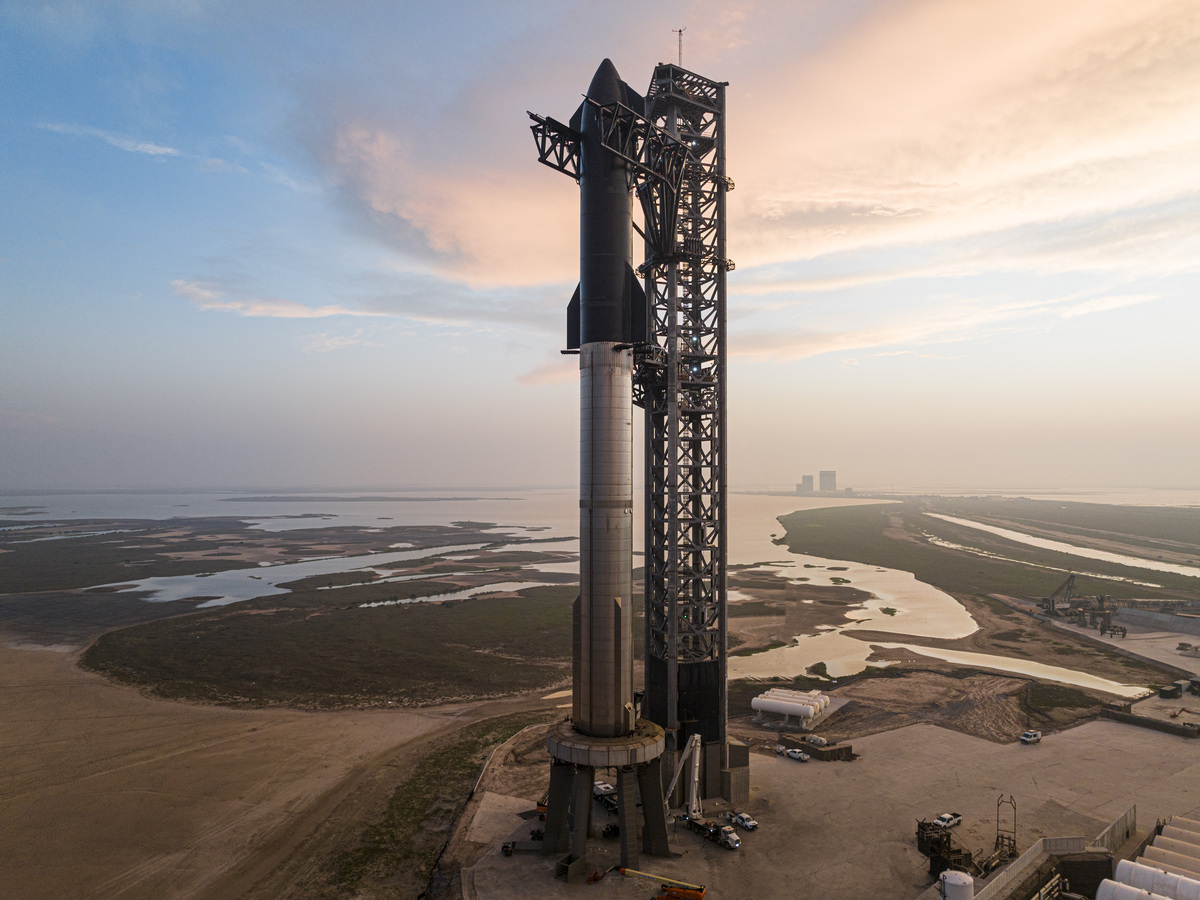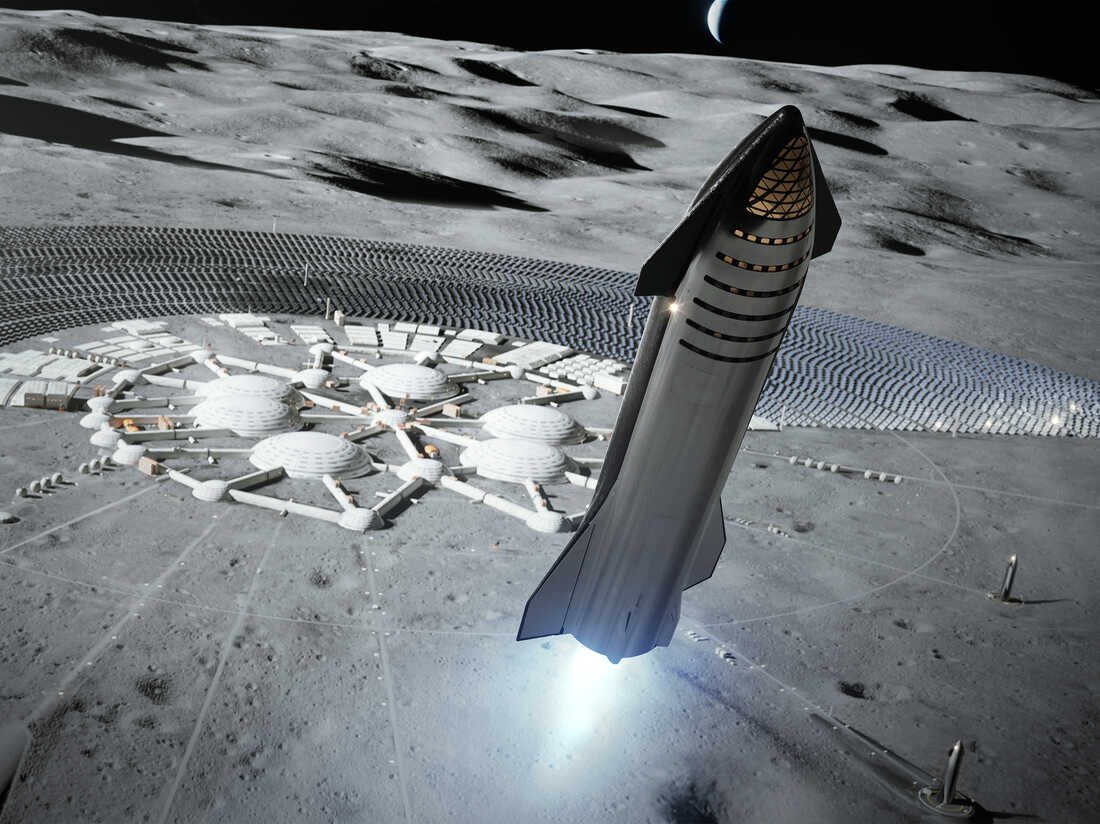SpaceX’s mega rocket Starship launches for a test flight from Starbase in Boca Chica, Texas, on Saturday.
Eric Gay/AP
hide caption
toggle caption
Eric Gay/AP


SpaceX’s mega rocket Starship launches for a test flight from Starbase in Boca Chica, Texas, on Saturday.
Eric Gay/AP
Amid wild cheers and applause, SpaceX’s giant Starship rocket successfully lifted off around 8:03 a.m. ET from its launch pad in Texas. The Starship successfully separated from its first-stage booster as planned. But minutes later, the cheers subsided as mission control appeared to lose contact with the vehicle. SpaceX said it believes that Starship’s self-destruct system activated, presumably because of a problem on board.
This was the SpaceX’s second attempt to launch the largest rocket the world has ever seen. The stainless-steel monster stands nearly 400 feet tall. Its massive first stage, known only as “Super Heavy,” is powered by 33 Raptor engines that must fire in perfect synchrony to carry Starship into orbit.
Congratulations to the entire SpaceX team on an exciting second integrated flight test of Starship!
Starship successfully lifted off under the power of all 33 Raptor engines on the Super Heavy Booster and made it through stage separation pic.twitter.com/JnCvLAJXPi
— SpaceX (@SpaceX) November 18, 2023
SpaceX founder Elon Musk hopes that Starship can one day become a cheap, rapidly reusable system that will jumpstart human exploration of the moon and Mars.
The plan for this second launch attempt was to lift off from Texas, briefly enter space and then splash down in the Pacific Ocean near Hawaii. But making it all the way through flight was always going to be a difficult goal to reach.
Here’s more on Starship and what this latest test means for the company.


Starship is the largest rocket ever built. Elon Musk hopes it will one day carry people to Mars.
SpaceX
hide caption
toggle caption
SpaceX


Starship is the largest rocket ever built. Elon Musk hopes it will one day carry people to Mars.
SpaceX
Starship’s first flight in April did not go according to plan
The first test flight of any rocket is going to be tough — and for its April 20 launch attempt, SpaceX tried to manage expectations. Somewhat tongue-in-cheek, the official countdown timeline promised “excitement guaranteed” after the launch.
The rocket lifted off shortly after 8:30 a.m. local time. Almost immediately it was clear that some of the 33 engines in the first stage had failed, and as it climbed into the sky, further engines flamed out.
Before the Starship could separate from its booster, the entire rocket began spinning out of control. It exploded roughly 4 minutes into flight.


Starship’s first launch attempt ended in failure. The rocket spun out of control before exploding about four minutes after liftoff.
Eric Gay/AP
hide caption
toggle caption
Eric Gay/AP


Starship’s first launch attempt ended in failure. The rocket spun out of control before exploding about four minutes after liftoff.
Eric Gay/AP
In the aftermath, it emerged that Starship’s flight termination system, which was designed to destroy the vehicle if it went out of control, had failed to do its job. On top of that, the rocket’s first stage pulverized the concrete launch pad during liftoff, sending particulate dust and chunks of debris flying.
The failure of the pad in particular was embarrassing, says Jonathan McDowell, an astronomer at the Center for Astrophysics, Harvard & Smithsonian. “This enormous rocket basically blew the pad apart and showered concrete over miles of Texas,” he says.
These rocketry goof-ups also caught the eye of government regulators. The Federal Aviation Administration grounded Starship pending a safety and environmental review. Earlier this week, the regulator cleared SpaceX for a second try, in part because of changes the company made to the design.
This time, SpaceX made some major upgrades
First, engineers have added more oomph to Starship’s self-destruct system. They put in larger explosive charges meant to destroy the beefy rocket, if it strayed off course as it did back in April.
That investment seemed to pay off on Saturday. As Starship’s second stage neared the end of its flight, mission control suddenly lost contact. The company says that the automated flight termination system triggered very late in the rocket’s burn.
In a statement, the FAA said Starship was lost due to an “anomaly.”
“No injuries or public property damage have been reported,” the agency said.
For this second test, the company also created an entirely new system for attaching the Starship to its booster rocket. It allows the spacecraft to use its engines to separate from the booster during flight, and continue its journey into orbit. But this so-called “hot staging” strategy is new to SpaceX, and isn’t used very often on American rockets.
It appeared to work well, allowing Starship to smoothly power away from the Super Heavy booster. But shortly after separation, the booster, which is supposed to be reusable, exploded. Hot staging can cause damage to the booster, though it’s too early to say if that’s what happened.
Third, the Super Heavy booster rocket being used in this flight has some considerable improvements over the previous one, the company claims. Most importantly, it uses an electrical mechanism to control the thrust of its dozens of engines. Sure enough, all 33 engines on the first stage appeared to perform flawlessly throughout the flight.
Super Heavy Booster 9 static fire successfully lit all 33 Raptor engines, with all but two running for the full duration. Congratulations to the SpaceX team on this exciting milestone! pic.twitter.com/1hzs768vHg
— SpaceX (@SpaceX) August 25, 2023
Finally, there was a big upgrade to the launchpad, which got blasted in the first flight test. This time, SpaceX has installed a water deluge system that should keep the pad from getting too hot. Such systems are commonly used for other launch pads. Again, the spaceflight company seemed to come out with a win: No chunks of concrete were reported flying from the pad.
Starship is a big part of SpaceX’s business plans
SpaceX is investing heavily in Starship. Musk has previously said that the company has spent $2 billion this year alone in development.
The company has focused on the mammoth rocket in part because Starship is central to Musk’s dream of colonizing Mars. He hopes that a fleet of starships will one day be able to put enough supplies into orbit to carry the first settlers to the red planet.
The rocket is also a big part of SpaceX’s business with NASA. The space agency has awarded around $4 billion in contracts to SpaceX so that it can develop Starship into a lunar lander. NASA plans on using a version of the rocket for some of its upcoming Artemis missions to the moon’s surface, which could start as soon as 2025.
Finally, Starship has a very important role in SpaceX’s business much closer to Earth. The company’s Starlink satellite internet system is awaiting a major upgrade, but SpaceX’s current rockets aren’t big enough to carry the newest, third generation of Starlink satellites into orbit, according to Chris Quilty, the president of Quilty Space, a private space analytics firm.
“Not only is the development of Starship burning a ton of cash, but it’s also holding back their ability to launch these gen-3 satellites,” Quilty says.
It worked! Kind of.


NASA is paying SpaceX billions to develop Starship into a lunar landing craft, but first it has to prove itself on Earth.
SpaceX
hide caption
toggle caption
SpaceX


NASA is paying SpaceX billions to develop Starship into a lunar landing craft, but first it has to prove itself on Earth.
SpaceX
Ahead of this test, it wasn’t clear how Starship would perform. SpaceX conducted two test fires of the new Super Heavy booster in August. The first, conducted on Aug. 6, ended prematurely after four engines failed to function properly. The second, conducted on Aug. 22, was successful, although two engines failed to run for the full duration of the six-second test.
McDowell says given that the first stage worked, and Starship separated from its booster and kept flying, this test should be considered a “successful failure,” even though it eventually exploded.
Quilty believes that SpaceX’s business won’t be affected by the test. The company is currently dominating the market for launching commercial satellites, thanks in part to past innovations, like a first stage that can land vertically on a barge. “They’re doing absolutely fine without Starship,” he says.
But McDowell adds that given the big ambitions of SpaceX, this monster rocket will have to make it all the way into space sooner or later.
“They need Starship to work eventually,” he says. “The big question for me is: ‘How much eventually can they get away with? How many failures can they tolerate?’ “
This story originally appeared on NPR





